“Project Tiger”, now ongoing as a Centrally Sponsored Scheme, was launched by the Government of India in 1973 in nine reserves of different States (Assam, Bihar, Karnataka, Madhya Pradesh, Maharashtra, Odisha, Rajasthan, Uttar Pradesh and West Bengal) over an area of approximately 14,000 sq. km.
Since then, the project coverage has expanded considerably to 50 tiger reserves (TR), encompassing an area of around 72749 sq.km. in 18 tiger States with 40145.03 sq.km. of notified core/ critical tiger habitats and 32603.72 sq.km. of buffer / peripheral areas in 18 tiger States. This amounts to 2.21% of the country’s geographical area.
Tiger is an “umbrella species” which ensures viable populations of other wild animals (co-predators, prey) and forest, thereby ensuring the ecological viability of the entire area and habitat, which also ensures the water and climate security of the region.
The following activities are funded under Project Tiger:
(i) anti-poaching initiatives;
(ii) strengthening infrastructure within tiger reserves;
(iii) habitat improvement and water development;
(iv) addressing man-animal conflicts;
(v) co-existence agenda in buffer and fringe areas with landscape approach;
(vi) deciding inviolate spaces and relocation of villages from critical tiger habitats within a time-frame by providing a better relocation package, apart from supporting States for settlement of rights of such people;
(vii) rehabilitation of traditional hunting tribes living in and around tiger reserves;
(viii) providing support to States for research and field equipments;
(ix) supporting States for staff development and capacity building in tiger reserves;
(x) mainstreaming wildlife concerns in tiger bearing forests outside tiger reserves, and fostering corridor conservation in such areas through restorative strategy involving local people to arrest fragmentation of habitats;
(xi) providing safeguards and retrofitting measures in and around tiger reserves and tiger bearing forests for wildlife conservation;
(xii) strengthening the infrastructure of National Tiger Conservation Authority at the Centre;
(xiii) carrying out independent monitoring and the evaluation of tiger reserves;
(xiv) establishment and development of eight new tiger reserves;
(xv) provision of project allowance to all categories of staff working in tiger reserves;
(xvi) providing residential amenities to facilitate basic education to children of frontline field staff posted in tiger reserves;
(xvii) providing assistance to States for fostering ecotourism to benefit local people.
Under Project Tiger, 60% Central Assistance is being made available to States for expenditure on all non-recurring items; for recurring items, the Central Assistance is restricted to 50% of the expenditure, while the matching grant is provided by the Project States.
In context of North Eastern and Himalayan States, 90% Central Assistance is being made available to States for expenditure on all non-recurring items; for recurring items, the Central Assistance is also restricted to 90% of the expenditure, while the matching grant is provided by the Project States.
Under Project Tiger, 60% Central Assistance is being made available to States for expenditure on all non-recurring items; for recurring items, the Central Assistance is restricted to 50% of the expenditure, while the matching grant is provided by the Project States.
In context of North Eastern and Himalayan States, 90% Central Assistance is being made available to States for expenditure on all non-recurring items; for recurring items, the Central Assistance is also restricted to 90% of the expenditure, while the matching grant is provided by the Project States.
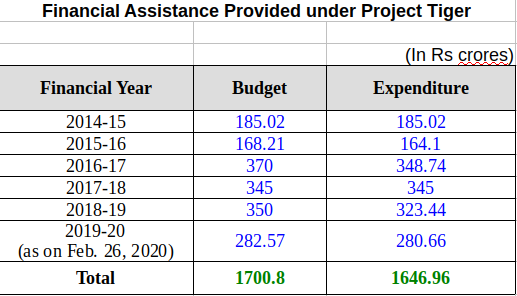
The countrywide assessment of tiger status uses a double sampling approach to estimate the distribution and abundance of tigers in India. The first component of the double sampling consists of ground surveys of all potential tiger bearing forests in 18 States wherein the following information is collected by the State Forest Department personnel:
• Ground surveys for determining occupancy of habitat patches by tigers and other predators
• Line transects to estimate prey abundance
• Sampling plots on the line transects to assess
• Habitat characteristics
• Human impacts and
• Prey dung density.
Alongwith the information generated by the ground surveys, latest remotely sensed data on (a) landscape characteristics, (b) human “foot-print”, and (c) habitat attributes are subsequently used to model tiger occupancy and abundance.
The second component of the double sampling consists of (a) scientifically rigorous abundance estimation in select sampling units using a remote camera trap based capture recapture technique for estimating tiger and other carnivore abundance and (b) line transect based Distance sampling for estimating prey abundance.
To keep a pulse on tiger numbers every year, the NTCA has issued a protocol titled ‘Phase IV’ monitoring of tiger reserves wherein all tiger source areas are required to undertake camera trap based monitoring with the objective of arriving at the minimum tiger numbers. Further this data is archived in the national repository of camera trap photographs of tigers (NRCTPT) which not only aids in tiger estimation, wildlife crime investigation but also helps understand tiger land tenure dynamics and occupancy over time.
The Government of India through the National Tiger Conservation Authority has issued Standard Operating Procedure for Active Management of Tiger Populations from Source areas at the Landscape level which based on sound genetic science and informs concerned field authorities where to translocate and reintroduce tigers in the event that a certain area starts functioning beyond its carrying capacity.
The National Tiger Conservation Authority (Normative Standards for Tourism Activities and Project Tiger) Guidelines 2012 provide for safeguards and retrofitting measures for heavily used infrastructure like roads, railway tracks and electric lines passing through tiger bearing forests so that such measures can be financially supported under the ongoing Centrally Sponsored Scheme of Project Tiger.
The National Tiger Conservation Authority (Normative Standards for Tourism Activities and Project Tiger) Guidelines 2012 ensure that minimal area of core/critical tiger habitats in accordance with tiger ecology and land tenure dynamics is made available to tourism. It has been recommended that only 20% of the core/critical tiger habitat be made available which however, should be limited to the existing usage, if less than 20%, and eventually phased out in the long term.
Population Habitat Viability Analysis (PHVA) on tiger ecology indicates that an inviolate space of 800-1200 sq. km. is required for a viable tiger population of 80-100 tigers which should have a minimum of 20 breeding females and a sex ratio skewed towards females.
Communities are involved directly and indirectly in tiger conservation. Under the ongoing Centrally Sponsored Scheme of Project Tiger, 25 lakh mandays are generated through direct engagement as anti-poaching watchers, fire watchers, drivers, elephant mahawats, nature guides besides ministerial staff.
Indirectly, people are engaged in several ecological development works such as Self-help Groups in thematic areas, support to farmstead, micro-finance, alternative livelihood support to name a few.
1. M-STrIPES (Monitoring System for Tigers Intensive-Protection & Ecological Status)
This is an android application which has three distinct modules namely Patrol module, Ecological module and Conflict module. The Patrol module inter-alia is a mechanism to ensure accountability of front line staff vis-à-vis anti-poaching efforts and useful for the tiger reserve management to strengthen protection measures, based on data that is generated through M-STrIPES. The ecological module assists in collecting biological data from the field which is utilised in the quadrennial All India Tiger Estimation and annual Phase IV exercise.
2. UAV (Unmanned Aerial Vehicle)
Project titled ‘E-Bird Technology for Tiger Conservation : Development and Integration of Unmanned Aerial Vehicles (UAV) as a Surveillance and Monitoring tool for Protection of Tiger and Capacity Building of Frontline Staff’ has commenced in13 tiger landscapes. A trainer drone has been fabricated along with development of a trainer manual for field staff.
3. Conservation Genetics
This technique of non-invasive genetic sampling of tiger scat is used in low tiger density areas to detect tiger presence or minimum number of tiger individuals. DNA extracts from scat samples are collected from field and identified by a tiger specific DNA marker. This has also been used to carry out a genetic assessment of relatedness between India’s tiger populations.
4. Artificial Intelligence
Owing to the large amount of camera traps photographs of tigers and wildlife collected during the 2018 cycle of the All India Tiger Estimation (nearly 3.5 crores) concepts from artificial intelligence were used to segregate species wise photographs.
Management interventions are codified for tiger reserves through the Tiger Conservation Plan mandated under Section 38 V of the Wildlife (Protection) Act, 1972.
The Tiger Conservation Plan is a document mandated under Section 38 V of the Wildlife (Protection) Act, 1972 for each tiger reserve, which prescribes management interventions for the said tiger reserve.
A Tiger Conservation Plan consists of three parts namely :
(i) Core Plan
(ii) Buffer Plan
(iii) Adjoining Area/Corridor Plan
The details of human deaths due to tiger attack are given below:
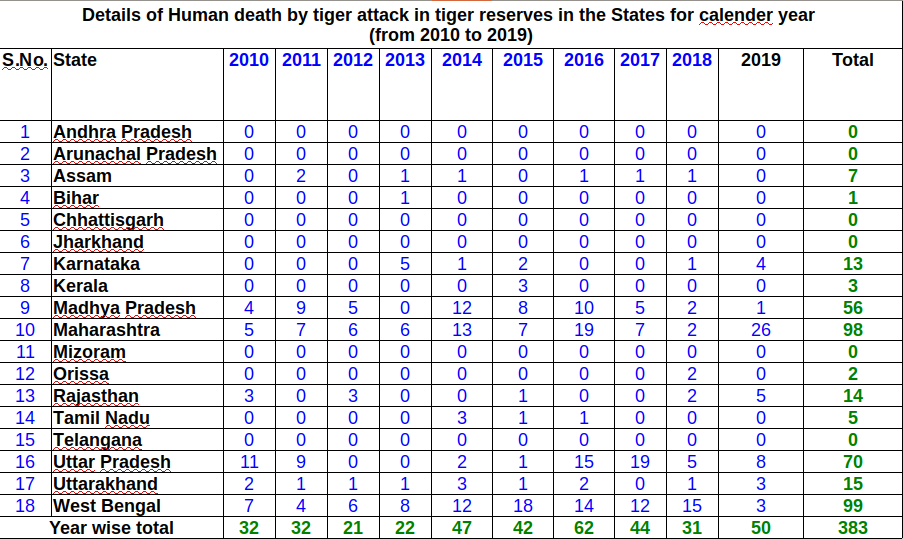 .
.
The details of compensation paid are given below:
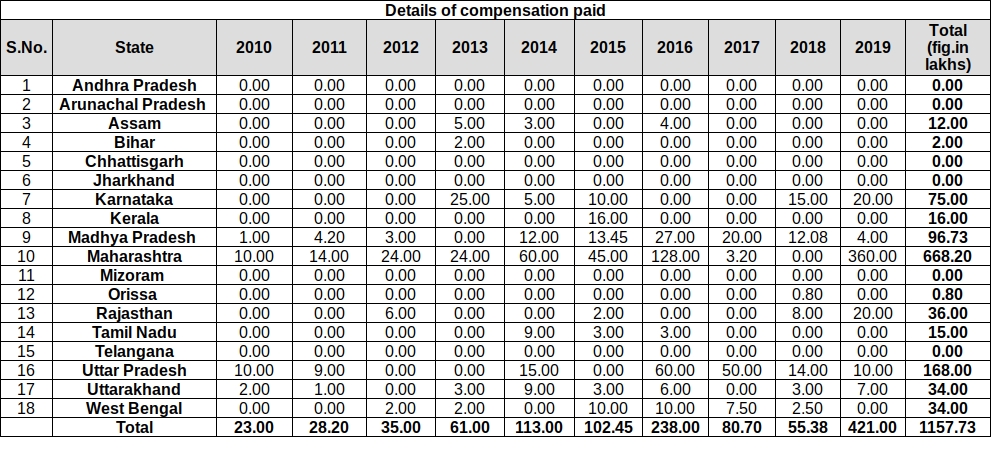
A three pronged strategy has been advocated by the National Tiger Conservation Authority to manage human tiger negative interactions as follows:
(i) Material and logistical support:
Funding support through the ongoing centrally sponsored scheme of Project Tiger, is provided to tiger reserves for acquiring capacity in terms of infrastructure and material, to deal with tigers dispersing out of source areas. These are solicited by tiger reserves through an Annual Plan of Operation (APO) every year which stems out from an overarching Tiger Conservation Plan (TCP), mandated under Section 38 V of the Wildlife (Protection) Act, 1972. Inter alia, activities such as payment of ex-gratia and compensation, periodic awareness campaigns to sensitize, guide and advise the general populace on man-animal conflict, dissemination of information through various forms of media, procurement of immobilization equipment and drugs and training and capacity building of forest staff to deal with conflict events is generally solicited.
(ii) Restricting habitat interventions:
Based on the carrying capacity of tigers in a tiger reserve, habitat interventions are proposed or restricted through an overarching Tiger Conservation Plan. In case tiger numbers are at carrying capacity levels, it is advised that habitat interventions should be limited so that there is no excessive spill over of wildlife including tigers thereby minimizing man-animal conflict. Further, in buffer areas around tiger reserves, habitat interventions are restricted such that they are sub-optimal vis-à-vis the core/critical tiger habitat areas, judicious enough to facilitate dispersal to other rich habitat areas only.
(iii) Standard Operating Procedures:
The National Tiger Conservation Authority has issued the following three SOPs to deal with man-animal conflict, which are available in public-domain;
(a) To deal with emergency arising due to straying of tigers in human dominated landscapes
(b) To deal with tiger depredation on livestock
(c) For active management towards rehabilitation of tigers from source areas at the landscape level.
The three SOPs inter alia address the issue of managing dispersing tigers, managing livestock kills so as to reduce conflict as well as relocating tigers from source areas to areas where density of tiger is low, so that conflict in rich source areas does not occur.
The details of tigers eliminated in conflict events is given below:

Details of tiger mortality from 2012-2019 are as follows:
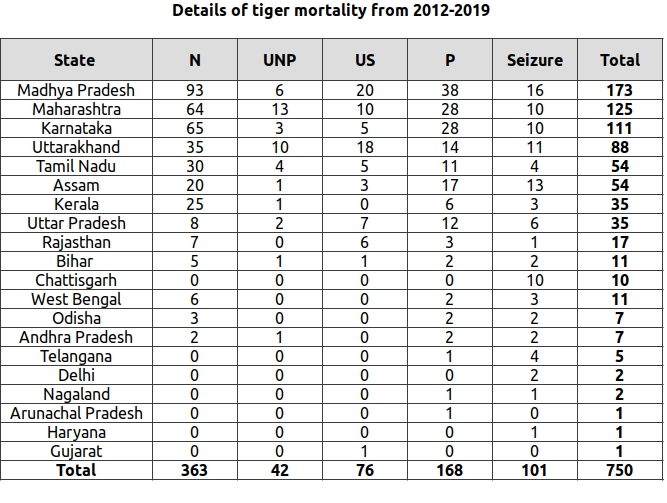
Details of tiger mortality due to various causes are as follows:
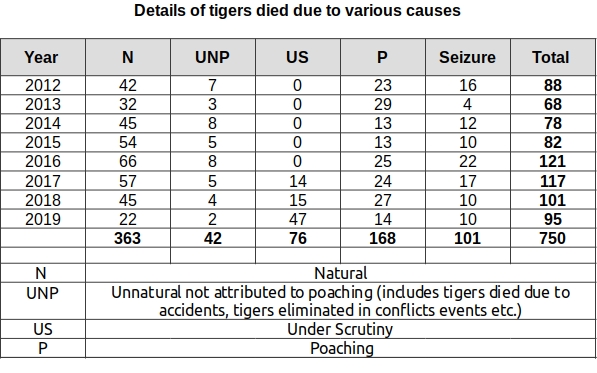
The Government of India has taken serious note of the tiger deaths in Goa and has constituted a two member team to investigate and recommend corrective measures. The team inter alia has recommended gearing up protection machinery in the State as well as bring the said area (Mhadei Wildlife Sanctuary) under the aegis of Project Tiger for focused management interventions. The State Government on their behalf have duly paid a compensation of Rs. 16000 to the affected farmer who lost livestock.
Details of tiger killed due to road and railway accidents.
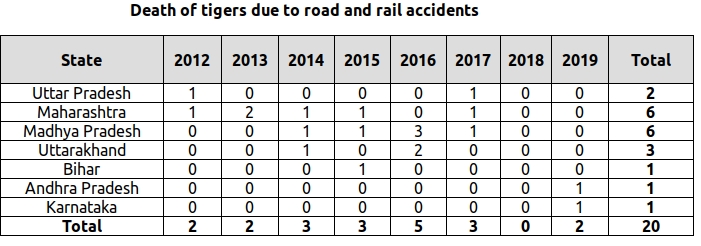
The reasons for tiger decline in areas outside tiger reserves and protected areas are as below:
(i) Degradation of forest status outside Protected Areas and Tiger Reserves owing to:
(a) human pressure;
(b) livestock pressure; and
(c) ecologically unsustainable land uses.
(ii) Fragmentation leading to loss of gene flow from source populations.
(iii) Loss of forest quality in terms of prey biomass.
(iv) Tiger deaths due to man-animal conflict.
(v) Tiger deaths due to poaching.
(vi) Loss of reproduction owing to disturbance on account of heavily used infrastructure like highways, etc.
(vii) Lack of adequate protection in outside areas.
(viii) Insurgency or law and order problems.
The Ranthambhore Tiger Reserve is part of a larger landscape comprising the protected areas of Ramgarh Vishdhari Wildlife Sanctuary, Bundi Territorial Division and the Mukundara Hills Tiger Reserve in Rajasthan, besides the Kuno-Palpur Wildlife Sanctuary alongwith Territorial Divisions of Datia in Madhya Pradesh.
With the Ranthambhore Tiger Reserve functioning at its carrying capacity, there is dispersal of tigers from this source area as per fundamentals of tiger land tenure dynamics owing to the presence of functional corridors as indicated above. Hence, the alleged missing tigers in all likelihood have dispersed in the adjoining landscapes.
Tiger reserves are evaluated quadrennially, based on a Management Effectiveness Evaluation (MEE) module which was developed using the Global IUCN World Commission of Protected Areas (WCPA) framework.
The WCPA framework consists of six elements namely context, planning, inputs, processes, outputs and outcomes. Each of these elements consists of certain criteria (totally 32) that are assessed to finally arrive at a score for each tiger reserve.
Tiger Reserves are graded as very good, good, fair and poor based on their score as follows:
• < = 40% rated as ‘Poor’
• 41-59% rated as ‘Fair’
• 60-74% rated as ‘Good’
• >=75% rated as ‘Very Good’
The carrying capacity of tigers in a particular habitat is the maximum population size that the said habitat can sustain in perpetuity, given the food resources, water and other requisite necessities available in the habitat.
Carrying capacity is calculated using the predictive equation of Hayward which is a mandatory component of the Tiger Conservation Plan required to be prepared for each tiger reserve under section 38 V of the Wildlife (Protection) Act, 1972.
Guidance document in the regard has been issued to all tiger range States and tiger reserves in 2014.
A viable tiger population is one which has 80-100 tigers with a minimum of 20 breeding females, with a sex ratio skewed towards females.
Tiger Reserves are notified by State Governments as per provisions of Section 38V of the Wildlife (Protection) Act, 1972 on advise of the National Tiger Conservation Authority.
The following steps are involved in the notification:
(a) Proposal is obtained from the State.
(b) In-principle approval is communicated from the National Tiger Conservation Authority, soliciting detailed proposals under section 38V of the Wildlife (Protection) Act, 1972.
(c) National Tiger Conservation Authority recommends the proposal to the State after due diligence.
(d) The State Government notifies the area as a Tiger Reserve.
An area of 72749 sq.km. of the country is notified through 50 tiger reserves in 18 tiger range States which constitutes 2.21% of the country’s geographical area. Out of this 40145.30 sq.km. is notified as core/critical tiger habitat while 32603.72 sq.km. is notified as buffer.
These processes are governed by Section 38W of the Wildlife (Protection) Act, 1972 whose provisions are as follows:
a. 38 W (1): “No alteration in the boundaries of a tiger reserve shall be made except on a recommendation of the Tiger Conservation Authority and the approval of the National Board for Wild Life”.
b. 38 W (2): “No State Government shall de-notify a tiger reserve, except in public interest with the approval of the Tiger Conservation Authority and the National Board for Wild Life”.
The average protected area size in India is around 212 sq. kms. which on their own cannot support a viable tiger population as described by Population Habitat Viability Analysis (PHVA).
The landscape approach to conservation involves viewing such protected areas as a network of populations interconnected to each other through corridors which shall be able to support viable tiger populations. These interconnected populations are referred to as meta-populations.
Areas linking one tiger reserve or protected area with another tiger reserve or protected area are not diverted for ecologically unsustainable uses, except in public interest and with approval of the National Board for Wildlife and on advice of the National Tiger Conservation Authority as per Section 38 O (1) (g) of the Wildlife (Protection) Act, 1972.
Further, Section 38 V (3) (b) of the said Act, provides for the tiger conservation plan to ensure ecologically compatible land uses in areas linking one protected areas or tiger reserve with another for addressing the livelihood concerns of local people, so as to provide dispersal habitats and corridor for spill over population of wild animal from the designated core areas of tiger reserves or from tiger breeding habitats with other protected areas.
The National Tiger Conservation Authority along with the Wildlife Institute of India has published a document “Eco-Friendly measures to mitigate impacts of Linear infrastructure on wildlife”, in letter and spirit of section 38 O (1) (g) of the Wildlife (Protection) Act, 1972 to safeguard wildlife and tigers from road accidents in linking / corridor areas.
The efficacy of these structures is being monitored by the National Tiger Conservation Authority in a project titled “Ecological impact assessment of existing and proposed road infrastructure in important wildlife corridors for strategic planning of smart green infrastructure” through the Wildlife Institute of India. This project has shown that critically endangered wildlife like tigers, dholes and gaur are successfully traversing these structures indicating their usefulness in avoiding road hits involving wild animals.
The National Tiger Conservation Authority alongwith the Wildlife Institute of India, in letter and spirit of section 38 O (1) (g) of the Wildlife (Protection) Act, 1972 have identified 32 major tiger corridors in the country and published them in a document titled “Connecting Tiger Populations for Long-term Conservation”, which are operationalized through prescriptions of a Tiger Conservation Plan mandated under section 38V of the said Act.
The NTCA alongwith the Wildlife Institute of India has conducted sensitization workshops for agencies involved in infrastructure development which inter-alia include Indian Railway Traffic Service Probationers, National Highways Authority of India personnel, Indian Railway Engineers, besides others.
Currently, Nagarhole-Bandipur-Mudumalai-Wayanad-Moyar-Segur, Corbett, Sundarbans (India and Bangladesh) and Kaziranga-Karbi Anglong have the required number of tiger for long term survival without immigration. The remaining tiger populations require habitat connectivity for genetic and demographic viability.
Available research data on tiger ecology indicate, that the minimum population of tigresses in breeding age, which are needed to maintain a viable population of 80-100 tigers (in and around core areas) require an inviolate space of 800 -1200 sq km. Tiger being an “umbrella species”, this will also ensure viable populations of other wild animals (co-predators, prey) and forest, thereby ensuring the ecological viability of the entire area or habitat. This inviolate area constitutes the core/critical tiger habitat.
Buffer areas surround the core/critical tiger habitat with forest connectivity are imperative for tiger dynamics, since such areas foster sub adults, young adults, transients and old members of the population. The young adults periodically replace the resident ageing males and females from the core population area.
The buffer area further, absorbs the “shock” of poaching pressure on populations of tiger and other wild animals. In case of severe habitat depletion in buffer areas, the source population would get targeted and eventually decimate.
Tiger occupied forests of India have been classified into following landscape complexes, namely:
(a) Shivalik Hills and the Gangetic Plains,
(b) Central India
(c) Eastern Ghats,
(d) Western Ghats,
(e) North-Eastern Hills and Brahmaputra Plains, and
(f) Sunderbans.
There are 50 tiger reserve across 18 Tiger Range States in India. For more information on tiger reserves.
The details are given in this document.
Since 2014 following tiger reserves have been notified in the country :
2014 : Pilibhit Tiger Reserve (Uttar Pradesh)
2014 : Bor Tiger Reserve (Maharashtra)
2015 : Rajaji Tiger Reserve (Uttarakhand)
2016 : Orang Tiger Reserve (Assam)
2017 : Kamlang Tiger Reserve (Arunachal Pradesh)
Tiger occupied forests of India have been classified into following landscape complexes, namely:
(a) Shivalik Hills and the Gangetic Plains,
(b) Central India
(c) Eastern Ghats,
(d) Western Ghats,
(e) North-Eastern Hills and Brahmaputra Plains, and
(f) Sunderbans.
The country level snapshot assessment of tigers, co-predators and prey is done quadrennially, using the refined methodology of double sampling, in collaboration with the Wildlife Institute of India and tiger States involving other national conservation NGOs as partners.
The fourth round of country level tiger status assessment completed in 2018, with the findings indicating an increase with a tiger population estimate of 2967, lower and upper limits being 2603 and 3346 respectively, as compared to 2014 estimation with a tiger population estimate of 2226, lower and upper limits being 1945 and 2491 respectively, country level estimation of 2010, with an estimate of 1706, lower and upper limits being 1520-1909 tigers, and 2006 estimation, with an estimate of 1411, lower and upper limits being 1165 and 1657. At present, India has around 75% of tiger population and its source areas amongst the 13 tiger range countries in the world, owing to its long history of conserving the species through Project Tiger (2.21% of country’s geographical area spread out in 50 tiger reserves in 18 States).
The details are given in this document.
The Wild Life (Protection) Act, 1972, as well as the Scheduled Tribes and Other Traditional Forest Dwellers (Recognition of Forest Rights) Act, 2006, require that rights of people (Scheduled Tribes and other traditional forest dwellers) recognized in forest areas within core and critical tiger or wildlife habitats of tiger reserves or protected areas may be modified and resettled for providing inviolate spaces to tiger or wild animals.
This requires payment of compensation (rights settlement in addition to the relocation package offered under the Centrally Sponsored Scheme at present). Chapter IV of the Wild Life (Protection) Act, 1972 (section 24) provides for acquisition of rights in or over the land declared by the State Government under section 18 (for constituting a Sanctuary) or section 35 (for constituting a National Park). Sub-section (2) of section 24 of the Wild Life (Protection) Act, 1972 authorizes the Collector to acquire such land or rights. Therefore, payment of compensation for the immovable property of people forms part of modifying or settling their rights which is a statutory requirement.
For this, the Government of India through the Centrally Sponsored Scheme of Project Tiger has a package with following two options, namely:
(a) Option I – Payment of the entire package amount (Rs. 10 lakhs per family) to the family in case the family opts so, without involving any rehabilitation or relocation process by the Forest Department.
(b) Option II – Carrying out relocation or rehabilitation of village from protected area or tiger reserve by the Forest Department.
This scheme has shown extremely positive results for eg. at the Satpura Tiger Reserve 36 villages out of 43 have been voluntarily rehabilitated which has resulted in an increase of tiger population from 26 in 2014 to 47 in 2018.
The rehabilitation process is monitored and implemented by the following two Committees, namely:
State level Monitoring Committee consisting of:
1. Chief Secretary of the State – Chairman
2. Secretaries of related departments – Members
3. State Principal Chief Conservator of Forests – Member
4. Non-official members of respective Tiger Conservation Foundation – Members
5. Chief Wildlife Warden – Member-Secretary
District level Implementing Committee for ensuring convergence of other sectors, consisting of:
1. District Collector -Chairman
2. Chief Executive Officer (CEO) – Member
3. Representative officials from Public Works Department (PWD), Social Welfare, Tribal Department, Health Department, Agriculture Department, Education Department, Power and Irrigation Departments – Members
4. Deputy Director of the tiger reserve or protected area – Member Secretary
754 Villages were present in core/critical tiger habitats out of which 180 villages have been voluntarily rehabilitated and 574 villages remain.
1. Generic measures
• Providing assistance to States under the Centrally Sponsored Scheme of “Project Tiger” for protection, infrastructure and antipoaching operations (including deployment of Tiger Protection Force and Special Tiger Protection Force)
• Providing grant through NTCA for patrolling in tiger rich sensitive forest areas outside tiger reserves
• Alerting the States as and when required
• Disseminating of real time information of backward / forward linkages relating to poachers / wildlife criminals.
• Advising the States for combing forest floor to check snares / traps
• Performing supervisory field visits through the National Tiger Conservation Authority and its regional offices
• Using information technology for improved surveillance (e-Eye system) using thermal cameras
• Launching tiger reserve level monitoring using camera trap to keep a photo ID database of individual tigers
• Preparing a national database of individual tiger photo captures to establish linkage with body parts seized or dead tigers
• Assisting States to deploy local workforce in a big way for protection to complement the efforts of field staff (In all, approximately 25 lakh mandays are generated annually with 50% central assistance amounting to around Rs. 25 crores (excluding matching 50% share given by States) under Project Tiger. Many local tribes constitute such local workforce (besides non-tribals), eg. Baigas, Gonds in Madhya Pradesh, Gonds in Maharashtra, Chenchus in Andhra Pradesh, Sholigas in Karnataka, Gujjars in Uttarakhand and Irulas in Tamil Nadu to name a few).
• Initiative taken for collaboration of National Tiger Conservation Authority and Wildlife Crime Control Bureau towards an online tiger/wildlife crime tracking / reporting system in tiger reserves and to coordinate with INTERPOL for checking trans-border trade of wildlife products.
• Insurance/Corpus Fund for staff of Kaziranga Tiger Reserve.
• Motivating tiger reserve administration / tiger States to ensure conviction of criminals through pursuance of cases in different courts.
• Bilateral co-operation with neighbouring countries like Nepal, Bangladesh, Bhutan and Russia.
• Sharing of information on seizure of body parts including skin of tigers among tiger range countries to ascertain source area. India has already made a proposal in this regard in CITES CoP-17 in Johannesburg which was agreed by member countries.
2. Security Plan
The National Tiger Conservation Authority has prepared generic guidelines for formulating a Security Plan for each tiger reserve which is operationalized in the overarching Tiger Conservation Plan which is legally mandated under section 38 V of the Wildlife (Protection) Act, 1972.
3. Security Audit
The National Tiger Conservation Authority has developed a framework for carrying out the assessment of the security threats and for formulating site specific security plan which has been completed in 25 different tiger reserves in Phase-I.
4. M-STrIPES (Monitoring System for Tigers Intensive-Protection & Ecological Status)
This is an android application which has three distinct modules namely Patrol module, Ecological module and Conflict module. The Patrol module inter-alia is a mechanism to ensure accountability of front line staff vis-à-vis anti-poaching efforts and useful for the tiger reserve management to strengthen protection measures, based on data that is generated through M-STrIPES. The ecological module assists in collecting biological data from the field which is utilised in the quadrennial All India Tiger Estimation and annual Phase IV exercise.
The STPF is a force which has been raised on lines of the India Reserve Battalion which is to be raised, armed and deployed in Tiger Reserves for focused anti-poaching operations. This force is funded by the Government of India and was initially deployed in four tiger reserves and since 2014 has been deployed in another four tiger reserves.
Following is the status of deployment of the STPF:
1. Tadoba-Andhari, Maharashtra
2. Pench, Maharashtra
3. Melghat, Maharashtra
4. Nawegaon-Nagzira, Maharashtra
5. Similipal, Odisha
6. Bandipur, Karnataka
7. Ranthambhore, Rajasthan
8. Kaziranga, Assam
As per the latest cycle of the All India Tiger Estimation, 2018 nearly 35% of tigers in India are found outside tiger reserves.
The National Tiger Conservation Authority (Normative Standards for Tourism and Project Tiger) Guidelines, 2012 prescribe mainstreaming wildlife concerns in tiger bearing forests and fostering corridor conservation through restorative strategy involving locals to arrest fragmentation of habitats which involves :
(a) Redressing man-animal conflict.
(b) Capturing problematic and aberrant wild animals.
(c) Monitoring of wild animals.
(d) Antipoaching operations.
(e) Habitat improvement measures.
The States are provided financial assistance under the Centrally Sponsored Scheme of Project Tiger for the above activities, for areas outside tiger reserves.
CA|TS is a tool or a comprehensive system that will provide a reference point to evaluate the existing management effectiveness of tiger conservation within integrated landscape planning, and ensuring that benefits from these efforts are optimized. CA|TS thus can be used as an overarching tool providing a standardized framework for assessing and measuring the overall impact of the work being carried in the existing tiger range across different landscapes.
It will provide an opportunity for the landscape/ Protected Area (PA) site, by enabling them with a common mechanism, to evaluate their management effectiveness through a scientific comprehensive reference point and also fix minimum standards for tiger conservation that these areas will need to aspire in order to fulfill their national and international commitments.
Making use of CA|TS will strengthen the PA network by assessing and measuring the overall conservation actions required for long term sustenance of tigers and co-existing species across the range.
In essence, it is a tool to identify gaps in management so that authorities concerned can take appropriate action to address the same.
In India, the implementation of CA|TS is considered in areas other than designated tiger reserves. It is a voluntary process for the Tiger Range States which helps in assessing quality of management inputs in areas outside tiger reserves.
Based on India’s strong intervention during the 62nd meeting of the Standing Committee of the Convention on International Trade in Endangered Species of Wild Fauna and Flora (CITES) at Geneva from 23-27 July, 2012, the Convention on International Trade in Endangered Species of Wild Fauna and Flora Secretariat has issued a notification No. 2012/054 dated the 3rd September, 2012 to Parties to fully implement Decision 14.69 and report to the Secretariat by 25 September, 2012 (Progress made on restricting captive breeding operations of tigers etc.).
Decision 14.69 entails ‘Parties with intensive operations breeding tigers on a commercial scale shall implement measures to restrict the captive population to a level supportive only to conserving wild tigers; tigers should not be bred for trade in their parts and derivatives.
During the 18th CoP held at Geneva in August 2019, based on an intervention from India, a slew of decisions were adopted to intervene in territories which had facilities for keeping big cats as a reinforcement of decision 14.69.
In addition India has signed a protocol on conservation of tigers with China and a Memorandum of Understanding with Bangladesh on conservation of the Sundarbans. Also the Cabinet has given nod to sign a Memorandum of Understanding with Myanmar to combat timber trafficking and conservation of tigers and other wildlife.
Besides bilateral engagements are being carried out with Bhutan, Nepal and Cambodia. The Government of Guatemala has solicited collaboration with the Govt. of India to safeguard their Jaguar population.
A tripartite, institute level has been signed between the National Tiger Conservation Authority, the Wildlife Institute of India, Dehradun and the A. N. Severtsov Institute of Ecology and Evolution, Russian Academy of Sciences for tiger conservation.
